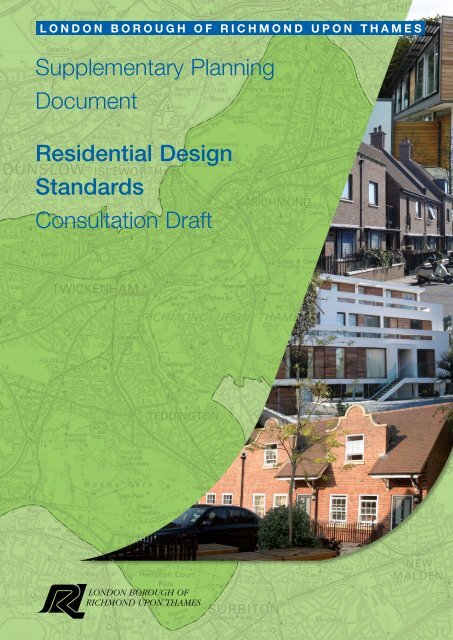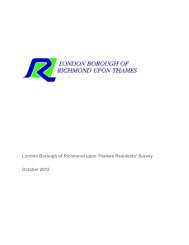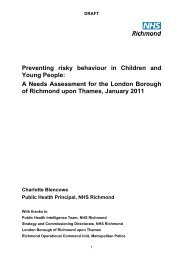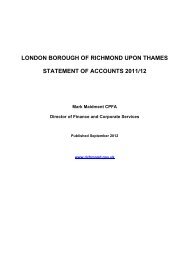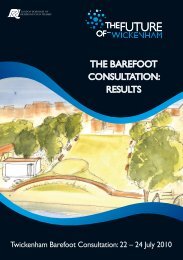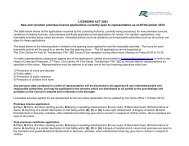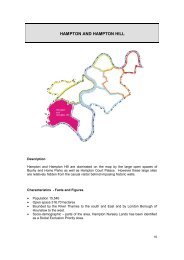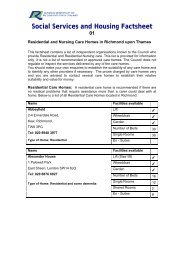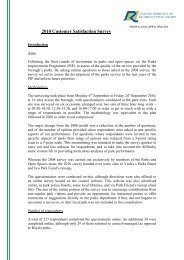Residential design standard - London Borough of Richmond upon ...
Residential design standard - London Borough of Richmond upon ...
Residential design standard - London Borough of Richmond upon ...
Create successful ePaper yourself
Turn your PDF publications into a flip-book with our unique Google optimized e-Paper software.
Supplementary Planning<br />
Document<br />
<strong>Residential</strong> Design<br />
Standards<br />
Consultation Draft
If you need this leaflet in Braille, <br />
large print, audio tape,<br />
or another language, <br />
please contact us on <br />
020 8891 7322<br />
or minicom 020 8831 6001<br />
Albanian<br />
Arabic<br />
Bengali<br />
Farsi<br />
Gujarati<br />
Punjabi<br />
Urdu
Contents <br />
Chapter<br />
Page<br />
1 Introduction 2 <br />
2 General principles 3 <br />
RESIDENTIAL AMENITY STANDARDS <br />
3 Neighbourliness 4 <br />
4 Privacy and space between buildings 5 <br />
RESIDENTIAL SPACE STANDARDS <br />
5 Garden and play space 6 <br />
6 Internal space and layout 8 <br />
7 Parking 11 <br />
DESIGN GUIDANCE FOR HOUSEHOLD EXTENSIONS <br />
8 Front and side extensions 12 <br />
9 Rear extensions and outbuildings 14 <br />
10 Light wells and basements 15 <br />
11 Garages 15 <br />
12 Ro<strong>of</strong>s 16 <br />
13 Sustainable <strong>design</strong> 19 <br />
14 Checklist for homeowners 21 <br />
Further information<br />
22 <br />
1
1 Introduction<br />
1.1 This guidance is indicative <strong>of</strong> the Council’s general approach on this subject and is<br />
not intended to stifle sensitive and imaginative <strong>design</strong>. Because <strong>of</strong> the diversity in<br />
residential character, house type and architectural style within the <strong>Borough</strong>, it is<br />
neither possible nor desirable to cover every type <strong>of</strong> change or eventuality for new<br />
residential development.<br />
1.2 With listed buildings greater care and attention is required. More restrictive policies<br />
will apply and Listed Building Consent may be required so please contact the Council<br />
for further advice. Where necessary in this document, additional <strong>design</strong> guidance is<br />
highlighted for conservation areas and historic buildings (both Listed Buildings<br />
and Buildings <strong>of</strong> Townscape Merit) applies to listed buildings.<br />
Status <strong>of</strong> document<br />
1.3 This Supplementary Planning Document (SPD) is for homeowners, architects and<br />
builders undertaking residential development or works to residential dwellings, and<br />
for <strong>of</strong>ficers and members <strong>of</strong> the Council to guide and promote high quality<br />
sustainable <strong>design</strong>, even when planning permission may not required. It is a material<br />
consideration when determining planning applications, having been through public<br />
consultation, and will be used to refuse proposals on the grounds <strong>of</strong> poor <strong>design</strong>.<br />
Planning policy<br />
1.4 The SPD supplements adopted policies within the Local Development Framework.<br />
The Core Strategy sets out strategic planning policy requirements for residential<br />
development (CP7, CP14). Development control policies relating to residential<br />
amenity (BLT15, BLT16), space <strong>standard</strong>s, layout and type <strong>of</strong> housing (HSG11,<br />
HSG14, HSG18, BLT11) and whether the <strong>design</strong>, scale and form has an adverse<br />
impact on the setting <strong>of</strong> the historic environment (BLT2, BLT3, BLT4) or views along<br />
the street in general (BLT11, BLT12) are all set out in the Saved Unitary<br />
Development Plan (these will eventually be superseded by policies within the<br />
Development DPD).<br />
Design guidance for Infill Development and Backland Development<br />
1.5 Design guidance for Infill Development and Backland Development, in addition to the<br />
relevant <strong>standard</strong>s in this document, can be found in the Council’s ‘Small and<br />
Medium Housing Sites SPD’. General guidance on good home <strong>design</strong> is also<br />
contained within that document.<br />
2
2 General Principles<br />
Balancing need and impact<br />
2.1 Councils have to ensure that, on balance, residential permissions:<br />
• Are <strong>of</strong> a high quality and built to a high <strong>standard</strong> (paragraph 10 <strong>of</strong> PPS3**)<br />
• Are not accepted if inappropriate to context or the character <strong>of</strong> the area (paragraph<br />
13 <strong>of</strong> PPS3**)<br />
• Complement the surrounding area and public realm and adapt to climate change<br />
(paragraph 16 <strong>of</strong> PPS3**)<br />
2.2 Extensions and conversions can make more effective use <strong>of</strong> urban land for modern<br />
living needs and well considered alterations to dwellings which complement the<br />
appearance <strong>of</strong> a property can <strong>of</strong>ten increase their value. However changes can<br />
harm the amenity <strong>of</strong> neighbouring occupiers through increased noise, disturbance<br />
and activity due to an intensification <strong>of</strong> use.<br />
Achieving good <strong>design</strong><br />
2.3 The Council will consider issues such as:<br />
• the scale <strong>of</strong> the proposal;<br />
• how much <strong>of</strong> the rear garden or yard will be covered;<br />
• the effect on the character and pattern <strong>of</strong> the surrounding area and whether it can<br />
be seen from the street;<br />
• parking levels and the layout <strong>of</strong> front gardens;<br />
• proposed new living conditions, outlook and privacy and the effect on neighbours’<br />
amenity;<br />
• safety and security issues;<br />
• sustainability and environmental issues;<br />
• whether it is subordinate (where necessary) to the main dwelling on the plot, and<br />
• the quality <strong>of</strong> the detailing and materials proposed.<br />
Careful repair and replacement<br />
2.4 The retention, restoration and repair <strong>of</strong> architectural features including windows and<br />
doors should be considered in the first instance.<br />
2.5 It is preferable to retain original exposed brickwork, particularly on historic<br />
buildings, and the Council discourages painting or rendering. When repairing or<br />
rebuilding, it is best to use bricks, bonding and pointing that match the existing<br />
building, preferably with a lime based mortar mix.<br />
2.6 Replacement windows and doors are most appropriate where their style and detail,<br />
height and depth <strong>of</strong> opening, proportions, position and thickness <strong>of</strong> glazing bars, and<br />
materials are traditional or in keeping with the original building. Painted timber is<br />
generally the preferred material, particularly in conservation areas. There is a<br />
presumption, where consent is required, against the use <strong>of</strong> uPVC (plastic) windows<br />
and doors. New windows and doors should line up with existing lintels and openings.<br />
** The Government’s national planning policies on housing is set out in Planning Policy<br />
Statement 3 (PPS3)<br />
3
RESIDENTIAL AMENITY STANDARDS
3 Neighbourliness<br />
Sunlight and daylight<br />
3.1 If no substantial loss <strong>of</strong> sunlight or daylight to adjoining dwellings and gardens occurs<br />
residential development will generally be acceptable subject to the overall <strong>design</strong><br />
quality, impact on the character <strong>of</strong> the area and sustainability <strong>of</strong> the proposal.<br />
3.2 Extensions should create good living conditions and should not cause any significant<br />
loss <strong>of</strong> daylight or sunlight to habitable rooms or gardens in neighbouring properties.<br />
In deciding the acceptability <strong>of</strong> the extension the council will be guided by the British<br />
Research Establishment (BRE) <strong>standard</strong>s.<br />
Sense <strong>of</strong> enclosure<br />
3.3 New dwellings or residential extensions which create an unacceptable sense <strong>of</strong><br />
enclosure or appear overbearing when seen from neighbouring gardens or rooms or<br />
from the street will not be permitted. This could be due to the height, footprint or<br />
proximity <strong>of</strong> the proposals to the surrounding area.<br />
3.4 Generally it would be advantageous to keep extensions away from the boundary,<br />
particularly if more than a single storey. Two storey rear extensions to terraced and<br />
semi-detached houses are <strong>of</strong>ten problematic because <strong>of</strong> their adverse effect on<br />
daylight and outlook.<br />
3.5 As a general rule, notwithstanding permitted development rights, the effect <strong>of</strong> a single<br />
storey extension is usually acceptable if the projection is no further than 3m for<br />
terraced, 3.5m for semi-detached and 4m for detached houses. However the final<br />
test <strong>of</strong> acceptability will depend on the particular circumstances on the site, position<br />
<strong>of</strong> the extension and type <strong>of</strong> property, which may allow larger rear projections to be<br />
granted consent. The distance from the neighbouring properties or the presence <strong>of</strong><br />
existing buildings or features on adjoining sites which reduces the physical impact <strong>of</strong><br />
the proposal will be taken into account, particularly for detached houses.<br />
3.6 Conversions or the introduction <strong>of</strong> new dormers and windows must not adversely<br />
compromise the living conditions <strong>of</strong> adjoining properties.<br />
4
4 Privacy and space between buildings<br />
4.1 Windows should not overlook a habitable room or garden <strong>of</strong> a neighbouring dwelling<br />
to an unreasonable degree. However public spaces and communal areas can<br />
benefit from overlooking from new dwellings due to passive surveillance. The degree<br />
<strong>of</strong> overlooking is affected by distance and the horizontal and vertical angles <strong>of</strong> view.<br />
4.2 Distances between habitable rooms <strong>of</strong> different units that directly face each other will<br />
be dependent on existing character and built form <strong>of</strong> the area. To ensure there is no<br />
significant loss <strong>of</strong> rear garden space nor an unacceptable sense <strong>of</strong> enclosure to the<br />
surrounding area is created, proposals that cover the existing garden space <strong>of</strong> a plot<br />
by 50% or more will not normally be permitted.<br />
4.3 Additional guidance on separation distances for new dwellings can be found in<br />
chapter 4 <strong>of</strong> the Council’s ‘Small and Medium Housing Sites SPD’.<br />
4.4 Design solutions such as the use <strong>of</strong> angled windows or obscure glazing can <strong>of</strong>ten<br />
overcome adverse overlooking to existing residential properties. However if these<br />
architectural techniques are necessary across a large proportion <strong>of</strong> a building<br />
frontage then a blank facade will be created which could adversely affect the<br />
character and appearance <strong>of</strong> the dwelling and reduce natural surveillance to the<br />
street.<br />
4.5 Generally rooms needing less privacy such as kitchens and living rooms can face the<br />
street. Frosted windows can be used for bathrooms and smaller windows for<br />
bedrooms. Landscape planting can also help screen ground level rooms.<br />
4.6 To prevent adverse overlooking and general unneighbourliness, windows should<br />
either be high level or omitted from any wall directly facing a neighbouring house or<br />
garden.<br />
4.7 Using the ro<strong>of</strong> <strong>of</strong> an extension as a terrace and proposals for balconies to ro<strong>of</strong><br />
extensions will normally be unacceptable as it will create overlooking and general<br />
unneighbourliness.<br />
4.8 Where houses are terraced or have small gardens the construction <strong>of</strong> a larger<br />
dormer window in the ro<strong>of</strong> can seriously reduce the privacy <strong>of</strong> neighbours. Minimise<br />
overlooking by restricting the size <strong>of</strong> window and setting the dormer back from the<br />
eaves.<br />
Infilling <strong>of</strong> gaps<br />
4.9 Extensions to the side elevation <strong>of</strong> a house, which would result in the significant<br />
reduction <strong>of</strong> an existing important space or gap between neighbouring houses, is not<br />
normally acceptable. This is particularly important for conservation areas and<br />
historic buildings where such infilling would result in the blocking <strong>of</strong> existing views<br />
<strong>of</strong> the sky or landscape behind pairs <strong>of</strong> semi-detached or detached houses within a<br />
suburban area. In conjunction with existing extensions to neighbouring buildings this<br />
can have a terracing effect on the street.<br />
5
RESIDENTIAL SPACE STANDARDS
5 Garden and play space<br />
5.1 Sufficient on site outdoor amenity space must be provided in new residential<br />
developments. Where play areas are deficient, a planning obligation provision <strong>of</strong>f<br />
site may be necessary.<br />
5.2 The type and size <strong>of</strong> space will vary according to the size and use <strong>of</strong> the dwelling<br />
unit. Accommodation likely to be occupied by families with young children should<br />
have direct and easy access to a good sized private garden. The aspect, useability<br />
and sense <strong>of</strong> enclosure will all be taken into account in assessing whether the private<br />
garden provided sufficiently good living conditions.<br />
5.3 Ground level family units (<strong>of</strong> 3 or more bedrooms) within a block <strong>of</strong> flats should have<br />
larger private amenity spaces. Flats at upper levels may share a community garden<br />
or have a private balcony area. In subdivided buildings, useable and accessible<br />
private outdoor space should be provided for as many new units as possible.<br />
5.4 Balconies should be <strong>design</strong>ed as an integral part <strong>of</strong> the building’s elevation, and not<br />
located in a position which results in unacceptable loss <strong>of</strong> privacy to other units or<br />
existing nearby dwellings.<br />
Children’s play areas<br />
5.5 All new residential development which may result in ten or more children living in the<br />
new units should provide suitable play space as part <strong>of</strong> the development scheme,<br />
based on 10 sqm per child in addition to general amenity space. The Council will use<br />
the Mayor <strong>of</strong> <strong>London</strong>’s ‘Providing children’s and young people’s play and informal<br />
recreation SPG’ when calculating requirements:<br />
http://www.london.gov.uk/mayor/strategies/sds/docs/spg-children-recreation.pdf<br />
5.6 Play areas should contain safe equipment, be easily accessible and overlooked by<br />
family houses where possible, enclosed by fencing or railings.<br />
5.7 The Council may also require a financial contribution in line with its Planning<br />
Obligations Strategy.<br />
Private and communal gardens<br />
5.8 Communal gardens should, as a minimum:<br />
• Receive sunlight, even in the winter months, and sufficient shade in summer<br />
months,<br />
• Be screened from parking areas,<br />
• Be easily accessible to all occupants,<br />
• Be overlooked by habitable rooms to ensure safety, and<br />
• Have a landscape management and maintenance plan.<br />
5.9 The Council will not include driveway or parking areas, or small strips <strong>of</strong> land which<br />
would not provide adequate or useable areas.<br />
5.10 Private and shared gardens should also be sheltered from busy roads by being<br />
located to the rear <strong>of</strong> buildings, back to back, behind perimeter blocks or in<br />
courtyards. Back to back is best in providing defensible private spaces.<br />
6
Front gardens<br />
5.11 Front gardens are important features in the townscape and can contribute to<br />
biodiversity. They can give adequate privacy to ground floor windows, improve the<br />
setting <strong>of</strong> a dwelling and mediate between public and private space.<br />
5.12 The demolition <strong>of</strong> substantial part or all <strong>of</strong> a front garden boundary, removal <strong>of</strong><br />
planting and the paving over <strong>of</strong> front gardens to provide residential car parking<br />
should be avoided. Where original front boundaries and gardens have been<br />
removed, consideration should be given to the reinstatement <strong>of</strong> the original pattern,<br />
particularly for conservation areas and historic buildings.<br />
5.13 Where walls, fences or railings are rebuilt care should be taken to reflect the<br />
established boundaries on the street in terms <strong>of</strong> height, <strong>design</strong> and materials. Where<br />
there is no consistent boundary pattern to follow, simple enclosures consisting <strong>of</strong> iron<br />
railings and/or brick are usually preferred. However tall solid front boundaries can<br />
result in a defensive and hostile street environment, which is generally not<br />
characteristic <strong>of</strong> the <strong>Borough</strong>. In most instances, new front boundaries over 1.5m in<br />
height are unnecessary.<br />
7
6 Internal space and layout<br />
Baseline <strong>standard</strong>s<br />
6.1 The footprint and room sizes <strong>of</strong> all residential proposals should adequately reflect the<br />
use and type <strong>of</strong> accommodation. Where floor areas and room sizes do not meet the<br />
following baseline <strong>standard</strong>s, it is up to the applicant to demonstrate the functionality<br />
<strong>of</strong> the rooms by portraying the main furniture items <strong>of</strong> conventional size in the floor<br />
plans.<br />
Flat unit type<br />
One-bed (1p or 2pp) <br />
Two-bed <br />
Three-bed <br />
Four + <br />
Net internal floor area<br />
45 sqm<br />
60 sqm<br />
70 sqm<br />
85 sqm<br />
Kitchen/Dining/Living area<br />
22 sqm<br />
24 sqm<br />
27 sqm<br />
30 sqm<br />
6.2 For houses: the size <strong>of</strong> the plot, number <strong>of</strong> storeys and character <strong>of</strong> the area will<br />
affect dimensions but as a baseline for the internal floor area for two-bed houses<br />
should be at least 65 sqm net, and three-bed houses 75 sqm.<br />
6.3 For all types <strong>of</strong> small units (one-bed) the Kitchen/Dining/Living areas (excluding<br />
access and stairs) should be at least 22sqm.<br />
6.4 All types <strong>of</strong> dwellings suitable for families (3 or more bedrooms), should preferably<br />
have a separate kitchen <strong>of</strong> at least 8sqm, or kitchen dining room <strong>of</strong> at least 12.5sqm.<br />
6.5 In all dwellings the main bedroom (double) should be 12 sqm, at least 2.6m wide.<br />
Any single bedrooms should be at least 7 sqm.<br />
6.6 All rooms should preferably have a head height <strong>of</strong> at least 2.3m over a large majority<br />
<strong>of</strong> the floor area (over 50%).<br />
6.7 Conversions from single residential dwellings or a non-residential building into two or<br />
more units should not result in cramped awkward layouts or access arrangements.<br />
Generally buildings <strong>of</strong> less than 100sqm are unlikely to provide satisfactorily layouts<br />
and will result in the loss <strong>of</strong> versatile housing suitable for families with children who<br />
need access to a garden. The subdivision <strong>of</strong> historic buildings or those in<br />
conservation areas should take account <strong>of</strong> original internal plan forms, special<br />
features and the external character and appearance <strong>of</strong> the area.<br />
6.8 Additional space <strong>standard</strong>s produced by bodies such as Mayor <strong>of</strong> <strong>London</strong>/Greater<br />
<strong>London</strong> Authority or the Homes & Communities Agency will be used by the Council<br />
as a benchmark to assess applications.<br />
Access<br />
6.9 Flats must be self contained with their own private entrance door which leads either<br />
directly from the street at ground floor or <strong>of</strong>f a common entrance hall. Internal rooms<br />
should lead <strong>of</strong>f a hallway or lobby to avoid passing between rooms wherever<br />
possible. Ideally access to flats within a converted building should be through the<br />
original main entrance, used as a shared hallway or lobby large enough to provide<br />
sufficient circulation space for resident’s day to day needs including pushchairs, and<br />
luggage.<br />
8
6.10 Larger dwellings, particularly those for families (3 or more bedrooms) should be<br />
located on ground floors with private garden spaces, or direct safe access to<br />
communal amenity areas. For all flats, access to communal amenity areas should be<br />
provided as direct as possible, especially if no private amenity space such as a<br />
balcony or terrace is provided from a single aspect unit. In subdivided properties, it<br />
would be desirable to provide a larger unit on the ground floor with direct access to a<br />
private garden area which can meet the needs <strong>of</strong> family housing.<br />
Layout and storage<br />
6.11 The layout <strong>of</strong> flats should be <strong>design</strong>ed so that rooms in different flats on different<br />
floors that are intended for similar purposes are in vertical alignment i.e. the stacking<br />
<strong>of</strong> bedrooms above bedrooms and living rooms above living rooms, to avoid noise<br />
disturbance to neighbours.<br />
6.12 Over intensification <strong>of</strong> a site through new residential proposals is illustrated by<br />
awkwardly shaped or arranged units and rooms that do not have satisfactory light,<br />
including solely north facing single aspects or by a large number <strong>of</strong> wholly internal<br />
kitchen areas with poor ventilation. Internal kitchens serviced by mechanical<br />
ventilation are generally not desirable. Kitchens and bathrooms should be located<br />
wherever possible to provide an openable window to the space.<br />
6.13 High densities can sometimes have a detrimental effect on the character and amenity<br />
<strong>of</strong> an area where the proliferation <strong>of</strong> refuse bins, meter boxes, extra cars in front<br />
gardens can lead to a cluttered and untidy streetscene. Care is required in the<br />
detailed <strong>design</strong> <strong>of</strong> such properties.<br />
6.14 Habitable rooms must be able to function for the purpose for which they are intended,<br />
in terms <strong>of</strong> shape, size and height and have both natural lighting and natural<br />
ventilation. Habitable rooms within basements should be preferably dual aspect to<br />
enhance cross ventilation and good daylight levels to otherwise compromised living<br />
conditions. Generally basements should be used for non-habitable or recreational<br />
areas rather than bedrooms or living rooms. Single unit flats should not be located<br />
solely in full basements.<br />
6.12 Adequate storage should be provided within room sizes utilising recesses and<br />
otherwise unusable spaces in conversions or awkward corner areas to rooms in new<br />
builds. Bedrooms should be capable <strong>of</strong> accommodating built-in wardrobes or<br />
cupboards on internal walls, and the space planning <strong>of</strong> secondary bedrooms flexible<br />
enough to enable working from home as a small <strong>of</strong>fice or workplace.<br />
6.13 All rooms should be <strong>of</strong> a size and shape that allows adequate access to, and layout<br />
<strong>of</strong>, furniture and equipment. Applicants may be asked to provide possible room<br />
furniture layouts to demonstrate the acceptability <strong>of</strong> small unit sizes.<br />
9
Lifetime homes and wheelchair housing<br />
6.14 <strong>Residential</strong> schemes should meet Lifetime Homes <strong>standard</strong>s, while taking account <strong>of</strong><br />
other legislation for historic buildings. A good level <strong>of</strong> accessibility should be<br />
<strong>design</strong>ed into residential proposals from the outset and allow a dwelling to be<br />
adapted in the future should the need arise, supporting the changing needs <strong>of</strong> a<br />
family’s life cycle, from raising young children to declining mobility in old age. See<br />
the Joseph Rowntree Foundation: http://www.jrf.org.uk<br />
6.15 Where required, residential schemes should be <strong>design</strong>ed for, or capable <strong>of</strong> easy<br />
adaptation to, wheelchair housing. A number <strong>of</strong> units should be <strong>of</strong> a size and layout<br />
that allow wheelchair access and mobility within rooms, and some internal rooms<br />
may need to be larger than <strong>standard</strong> to be wheelchair compliant. This should include<br />
a fully wheelchair accessible shower facility or wet room.<br />
6.16 The Council will have regard to guidance on accessibility and wheelchair housing<br />
from the Mayor <strong>of</strong> <strong>London</strong>/Greater <strong>London</strong> Authority.<br />
http://www.london.gov.uk/mayor/strategies/sds/docs/spg_accessible_london.pdf<br />
10
7 Parking and other<br />
7.1 Sufficient planting should be provided, or should remain, when <strong>of</strong>f street parking<br />
areas are proposed. Permission will not be granted for <strong>design</strong>s that compromise<br />
highway safety or have an adverse impact on the external appearance <strong>of</strong> the building<br />
or area. A number <strong>of</strong> different parking arrangements can be considered for<br />
residential schemes, depending on the scale and form <strong>of</strong> the development including<br />
courtyards behind a street facing development and undercr<strong>of</strong>t or underground<br />
garages subject to the visual impact on the street particularly in conservation areas.<br />
7.2 To improve the appearance and biodiversity <strong>of</strong> parking areas, consideration should<br />
be given to the following:<br />
• Maintaining a sense <strong>of</strong> enclosure through the use <strong>of</strong> boundaries, gates, or<br />
planting. Open expanses <strong>of</strong> hard standing are generally unattractive and are<br />
unlikely to gain permission.<br />
• The provision <strong>of</strong> a separate entrance path to the front door.<br />
• Avoiding car parking spaces immediately adjacent to the windows <strong>of</strong> habitable<br />
rooms, to prevent visual intrusion and fumes.<br />
• Natural drainage by using permeable paving.<br />
• Planting <strong>of</strong> native species where appropriate.<br />
7.3 Frontage parking is only acceptable in conservation areas or to historic buildings<br />
where it is part <strong>of</strong> the character <strong>of</strong> the area and the loss <strong>of</strong> front gardens will be<br />
resisted where this would be detrimental to the setting <strong>of</strong> the area. Please also<br />
check if Article 4 Directions apply as these may restrict parking in front gardens.<br />
7.4 Always consider using traditional surfaces such as natural stone or granite setts.<br />
The texture and colour <strong>of</strong> any new materials should be sympathetic to the setting <strong>of</strong><br />
the building and wider street scene.<br />
7.5 Extensions and conversions involving the loss <strong>of</strong> parking will not normally be<br />
opposed as long the proposals comply with the Council’s ‘Front Garden and Other<br />
Off Street Parking Standards SPD’.<br />
Cycles<br />
7.6 Safe and secure cycle storage should be provided, <strong>design</strong>ed as integral to the<br />
property where possible, in line with the Council’s cycle <strong>standard</strong>s.<br />
Refuse and recycling<br />
7.7 Bins and boxes should generally be located behind the building line. Where there is<br />
not possible, an area <strong>of</strong> adequate size to accommodate this storage should be<br />
integrated into the front or side <strong>of</strong> a property or screened appropriately by the front<br />
boundary. Bin stores should be flexible enough to cope with any future increases in<br />
recycling needs.<br />
7.8 In subdivided properties, additional storage bins and recycling boxes will <strong>of</strong>ten be<br />
required.<br />
11
DESIGN GUIDANCE <br />
FOR HOUSEHOLD EXTENSIONS
8 Front and side extensions<br />
The principle <strong>of</strong> subordination<br />
8.1 To respect and complement the character <strong>of</strong> the host building an extension should be<br />
viewed as a smaller addition. Therefore extensions should generally be <strong>of</strong> a height<br />
one storey lower than the host building. This is to allow space to appreciate the<br />
original form <strong>of</strong> the building between any new addition and the existing eaves or<br />
parapet line and is particularly important in relation to buildings which occupy corner<br />
locations within the townscape, where two or more elevations are clearly visible in<br />
public views.<br />
Design and scale<br />
8.2 Side extensions should retain the rhythm, plot width and character <strong>of</strong> the existing<br />
streetscene by being set back from the frontage <strong>of</strong> a building, usually by 1 metre, and<br />
not infill important gaps between buildings.<br />
8.3 With regard to semi-detached pairs, terraces or other groups <strong>of</strong> houses, extensions<br />
which would upset important symmetry, balance or unity <strong>of</strong> such dwellings will not<br />
normally be permitted, particularly in conservation areas or on historic buildings in<br />
their own right.<br />
8.4 The demolition <strong>of</strong> projecting wings or outbuildings, which are considered to be an<br />
integral part <strong>of</strong> the architecture <strong>of</strong> the host building or contribute positively to its<br />
character, will not normally be acceptable.<br />
8.5 When extending a building two general approaches may be considered. An<br />
extension could be <strong>design</strong>ed to follow closely the existing character, materials and<br />
detailing <strong>of</strong> the host building. This straightforward approach is suitable for domestic<br />
houses, historic buildings and conservation areas, and should generally:<br />
• Use a ro<strong>of</strong> form (pitch and pr<strong>of</strong>ile) which is compatible with the existing ro<strong>of</strong> form <strong>of</strong><br />
the house. Matching materials are preferable.<br />
• Use matching or complementary materials for walls and match the bonding and<br />
pointing <strong>of</strong> brickwork to the host building.<br />
• Ensure the style and detail, depth <strong>of</strong> opening reveals, size, proportions, materials,<br />
and horizontal alignment <strong>of</strong> new windows and doors, including the <strong>design</strong> and<br />
detailing <strong>of</strong> surrounds or arches to openings, echo those <strong>of</strong> the host building.<br />
• Continue plinths, brick stringcourses, fascias and other such details <strong>of</strong> the host<br />
building where appropriate.<br />
Subject to impact on the amenity <strong>of</strong> neighbours and the infilling <strong>of</strong> any important gap between<br />
buildings, a traditional approach to side extensions should follow the overall <strong>design</strong>, proportion<br />
and ro<strong>of</strong> pr<strong>of</strong>ile <strong>of</strong> the main dwelling, set down and subordinate to the ridge <strong>of</strong> the ro<strong>of</strong>. Two<br />
storey extensions may be acceptable in some locations.<br />
12
8.6 Alternatively, an extension could be <strong>design</strong>ed in a more contemporary manner<br />
adopting a distinctly different character either using contrasting or contextual<br />
materials so long as the additional space, form and layout is well <strong>design</strong>ed, discreetly<br />
located, and sympathetic to the scale, form, details and proportions <strong>of</strong> the host<br />
building.<br />
8.7 Rainwater pipes and gutters should always be positioned in inconspicuous locations.<br />
Porches<br />
8.8 Adding an extension, such as a porch or canopy, to the front <strong>of</strong> a house can have a<br />
significant impact on the character <strong>of</strong> the building, and so all front extensions should<br />
be sensitively considered as to whether they are really needed even when planning<br />
permission is not required. They are not appropriate where:<br />
• the existing frontage is largely unimpaired by extensions and the proposal would<br />
dominate the elevation <strong>of</strong> a house,<br />
• it is considered important to retain the integrity <strong>of</strong> a group <strong>of</strong> dwellings as a whole, or<br />
• architectural features, windows or detailing which contribute positively to the <br />
character <strong>of</strong> the house would be lost.<br />
13
9 Rear extensions and outbuildings<br />
9.1 While extensions to the rear can be modern in architectural detailing, the character<br />
and appearance <strong>of</strong> historic buildings and conservation areas should inform the<br />
<strong>design</strong> in terms <strong>of</strong> materials, proportions and the size <strong>of</strong> window openings in these<br />
cases.<br />
9.2 The principle <strong>of</strong> subordination again applies (see 8.1) and rear extensions should be<br />
restricted to a single storey on small scale cottages or terraces, extending no further<br />
than original width <strong>of</strong> building and need not be much higher than 2.5m.<br />
9.3 Extensions above a single storey (if acceptable in terms <strong>of</strong> impact on neighbourliness<br />
and privacy) should be set in from the side boundary unless set against a blank flank<br />
boundary wall <strong>of</strong> 2 or more storeys in height.<br />
9.4 Infilling the remaining gap <strong>of</strong> a half width rear addition which creates a L-shape plan<br />
(<strong>of</strong>ten particular to historic buildings) with a single storey extension will generally<br />
be acceptable if it:<br />
• follows the rear building line and is <strong>of</strong> lightweight appearance e.g. a conservatory.<br />
• slopes down to the party wall to minimise the impact on neighbouring properties, and<br />
• does not ‘wraparound’ the whole original addition, unless the scale and volume<br />
remain subordinate to the main dwelling.<br />
Appropriate in more sensitive locations<br />
Appropriate in less sensitive situations with no<br />
impact on residential amenity<br />
9.5 In conservation areas the detailed <strong>design</strong> <strong>of</strong> rear extensions and conservatories<br />
should be <strong>of</strong> the highest quality and mass-produced glazed structures should be<br />
avoided. Building form and window proportions should harmonise with the character<br />
<strong>of</strong> the main dwelling especially if glimpsed from side views, corners, the public realm<br />
or open spaces, or be simple modern additions subservient in <strong>design</strong>, size and height<br />
that do not obscure architectural features or characteristic detailing. Materials and<br />
details should complement and be sympathetic to the main dwelling, and timber or<br />
metal are preferred for conservatories or joinery generally.<br />
9.6 Garden dwellings such as <strong>of</strong>fices and covered play areas should only be a single<br />
storey, set in from the boundary and generally no higher than 2.5m to avoid being a<br />
‘poor neighbour’, and not infill the majority <strong>of</strong> the garden area. Lighting should be<br />
minimised.<br />
14
10 Light wells and basements<br />
10.1 Extending an existing lightwell or the formation <strong>of</strong> a new basement visible within any<br />
public views may be acceptable where:<br />
• such features already form part <strong>of</strong> the prevailing character <strong>of</strong> a terrace or other<br />
building group or the surrounding townscape, or<br />
• their size and <strong>design</strong> will not detract from the original proportions <strong>of</strong> the front<br />
elevation <strong>of</strong> a building, nor obscure any architectural feature which contributes<br />
positively to the character <strong>of</strong> the building, and<br />
• horizontal grilles are used to enclose the area rather than railings and or vertical<br />
upstands, and<br />
• sufficient front garden area is retained to allow for adequate planting, bin enclosure<br />
and boundary treatment, and<br />
• Windows generally reflect the pattern and type <strong>of</strong> fenestration above, and<br />
• The depth <strong>of</strong> the lightwell is generally no more than 2m allowing light to basement<br />
windows rather than functioning as below ground level amenity areas.<br />
(diagram to be inserted if necessary)<br />
10.2 However such works in conservation areas or to historic buildings may not be<br />
appropriate, depending on the visibility and townscape importance <strong>of</strong> the building and<br />
uniformity <strong>of</strong> the street. They will not be acceptable if the special fabric or structural<br />
integrity <strong>of</strong> listed buildings is affected.<br />
10.3 Flood risk and flood mitigation measures will also be a deciding factor on the<br />
acceptability <strong>of</strong> all proposals.<br />
11 Garages<br />
11.1 Garages that make a positive contribution to the character <strong>of</strong> an area and are integral<br />
to the <strong>design</strong> <strong>of</strong> a single dwelling or group <strong>of</strong> buildings should be retained. Please<br />
check if Article 4 Directions apply restricting removal or alteration.<br />
11.2 In all other cases, the reuse <strong>of</strong> a garage for residential space may be acceptable<br />
where:<br />
• the doors or a ‘door like’ frontage is maintained;<br />
• windows match existing, where necessary or are <strong>design</strong>ed to fit within the garage<br />
opening;<br />
• there is no impact on neighbouring amenity;<br />
• the proposal improves energy efficiency <strong>of</strong> the garage; and<br />
• the character <strong>of</strong> conservation area or historic building is left unharmed.<br />
15
12 Ro<strong>of</strong>s<br />
General advice<br />
12.1 Most alterations to the ro<strong>of</strong> form will be acceptable in principle if they:<br />
• are not directly visible from the street<br />
• do not occupy a large majority <strong>of</strong> the ro<strong>of</strong> slope area;<br />
• do not adversely affect the amenity <strong>of</strong> neighbouring properties, and<br />
• exhibit good <strong>design</strong> and proportions appropriate to the building and surrounding area.<br />
12.2 However extensions at ro<strong>of</strong> level clearly visible from the street (i.e. on corner sites<br />
and front ro<strong>of</strong> slopes) will not be acceptable unless the scale <strong>of</strong> the main building is<br />
respected through good <strong>design</strong> and high quality materials. Extensions should not<br />
dominate the scale and form <strong>of</strong> the original ro<strong>of</strong> and cohesive groupings and ridge<br />
lines should generally be left intact. Hip to gable alterations will normally be<br />
resisted.<br />
12.3 There should be no overriding visual conflict with front gable features or the<br />
architectural unity or rhythm <strong>of</strong> the street or building, particularly conservation areas<br />
or historic buildings.<br />
Ro<strong>of</strong> lights<br />
12.4 Ro<strong>of</strong> lights are preferable when the scale, form or pr<strong>of</strong>ile <strong>of</strong> the existing ro<strong>of</strong> <strong>of</strong> a<br />
house cannot comfortably accommodate a ro<strong>of</strong> extension or result in a bulky, visual<br />
awkward proposal. In general no more than two ro<strong>of</strong> lights should be necessary to<br />
the front or side ro<strong>of</strong> slope, subject to Building Regulations, and they should generally<br />
align with windows below or be set close to the horizontal planes <strong>of</strong> the ro<strong>of</strong>, or<br />
hidden behind gables/chimneys, rather than being positioned in a random manner. It<br />
is always desirable that ro<strong>of</strong> lights be set flush with the existing ro<strong>of</strong> slope, using the<br />
“heritage style”, particularly in conservation areas or on historic buildings.<br />
Randomly positioned ro<strong>of</strong> lights<br />
that fill the ro<strong>of</strong> area have a<br />
detrimental impact on the overall<br />
quality <strong>of</strong> a building.<br />
A single ro<strong>of</strong> light that aligns with<br />
the windows on the elevation<br />
below, set flush with the ro<strong>of</strong> is<br />
preferable.<br />
16
Dormers<br />
12.5 Dormers should not dominate the existing ro<strong>of</strong> form but relate to the scale <strong>of</strong> the host<br />
building by generally adopting the form <strong>of</strong> modest individual traditional dormer<br />
windows particularly when visible from the street. Normally a significant area (0.5m)<br />
<strong>of</strong> the existing ro<strong>of</strong> should be left above, being set well down from the ridgeline, and<br />
left beneath, being set well up from the eaves line, and left to either side <strong>of</strong> a new<br />
dormer window on the ro<strong>of</strong>.<br />
12.6 It is desirable that they align with those windows on the lower storeys and adopt a<br />
width and height no larger than that <strong>of</strong> windows <strong>of</strong> the floors below, and following the<br />
general window style. In some cases a hip or gabled ro<strong>of</strong> to a dormer may be<br />
appropriate following the main building ro<strong>of</strong> form and in others, a modest lead dormer<br />
window with a flat ro<strong>of</strong> (in a simple modern <strong>design</strong>) may be preferable to reduce its<br />
bulk and scale.<br />
To the rear, a dormer should leave<br />
room around so it does not fill the<br />
ro<strong>of</strong> space.<br />
Large dormers which create<br />
additional floors are examples <strong>of</strong><br />
poor <strong>design</strong> and will be refused.<br />
To the front, ro<strong>of</strong> lights are preferred.<br />
If a dormer is acceptable it should be<br />
small and centrally placed or align<br />
with one window to the elevation<br />
below. This example would<br />
generally not be acceptable.<br />
17
Mansards and additional floors<br />
12.7 Normally, mansard ro<strong>of</strong> extensions will not fit with the character <strong>of</strong> the <strong>Borough</strong>.<br />
They may be acceptable if there is a historical precedent and only if there is an<br />
existing parapet behind which the mansard will be hidden. The <strong>design</strong> pr<strong>of</strong>ile and<br />
materials should be traditional in character and appearance and not flat topped.<br />
12.8 Additional floors are only considered appropriate <strong>design</strong> responses on modern<br />
buildings that have a flat ro<strong>of</strong> pr<strong>of</strong>ile and existing ro<strong>of</strong> level plant structures, otherwise<br />
the form and pr<strong>of</strong>ile <strong>of</strong> the ro<strong>of</strong> is altered and the original building will appear ‘top<br />
heavy’ and out <strong>of</strong> character. They are not a feature <strong>of</strong> conservation areas or<br />
historic buildings.<br />
Ro<strong>of</strong> terraces and balconies at ro<strong>of</strong> level<br />
12.9 Ro<strong>of</strong> terraces or balconies will only be acceptable if there is no adverse effect on<br />
<strong>upon</strong>:<br />
• the overall architectural integrity <strong>of</strong> the building,<br />
• the character <strong>of</strong> the area particularly in conservation areas,<br />
• the amenity <strong>of</strong> neighbouring occupiers, and<br />
• the level <strong>of</strong> skyline clutter.<br />
12.10 Therefore balconies proposed as part <strong>of</strong> a l<strong>of</strong>t conversion are normally unacceptable.<br />
Chimney stacks and pots<br />
12.11 When permission is needed, the removal <strong>of</strong> existing chimney stacks and pots will not<br />
normally be acceptable when, even if not in use, they make an important contribution<br />
to the townscape, particularly on historic buildings, on a terrace <strong>of</strong> buildings or in<br />
key views within conservation areas. Original brick or terracotta detailing to<br />
chimney stacks should be retained.<br />
12.21 It is desirable, if damaged, that chimneys and pots are repaired in a style and<br />
material which reflects the original.<br />
Telecomms and plant<br />
12.13 Satellite dishes, other telecommunication apparatus and other ro<strong>of</strong> top structures<br />
should not increase skyline clutter (sharing <strong>of</strong> equipment is welcomed) and be hidden<br />
from public view as far as possible, located to the rear <strong>of</strong> the house or on the rear<br />
ro<strong>of</strong> slope, utilising the smallest practical size.<br />
Materials and features<br />
12.14 Traditional materials such as natural slate, clay tile and lead are encouraged,<br />
depending on the original <strong>design</strong> and material <strong>of</strong> the building or dormer window.<br />
Retention and reuse <strong>of</strong> the following features is desirable, whether planning<br />
permission is required or not:<br />
• natural slates or clay tiles<br />
• decorative ridge tiles and ro<strong>of</strong> tile patterns<br />
• cornices, parapets and balustrades at ro<strong>of</strong> level<br />
18
13 Sustainable <strong>design</strong><br />
13.1 Energy efficient measures can be cost effective since the additional cost will be<br />
recovered in reduced fuel bills. It is recommended that home owners undertake an<br />
energy audit to identify adaptive measures to improve efficiency.<br />
13.2 Modern construction also requires increased ventilation and dual aspect dwellings<br />
and flats should be created wherever possible, to allow cross ventilation. New<br />
dwellings should aim to meet the highest sustainable ratings, exceeding Building<br />
Regulations where possible. See the Council’s ‘Sustainable Construction Checklist’<br />
for more information.<br />
Micro-renewables (solar panels, wind turbines and biomass flues)<br />
13.3 To safeguard residential amenity and facilitate the use <strong>of</strong> renewable energy (where it<br />
is financially viable for the homeowner), the Council expects that:<br />
• Micro-renewables are generally located to the rear <strong>of</strong> properties and not visible from<br />
the street particularly in conservation areas.<br />
• The special interest and original fabric <strong>of</strong> historic buildings is not compromised.<br />
• Noise and disturbance to neighbours is kept to a minimum and can be controlled.<br />
• Sufficient space has been <strong>design</strong>ed for maintenance and storage (particularly in the<br />
case <strong>of</strong> biomass).<br />
13.4 If a front or side ro<strong>of</strong> slope is the optimum micro-renewable location, it would be<br />
preferable if it was:<br />
• positioned close to existing chimney stacks (especially in the case <strong>of</strong> flues);<br />
• hidden on or behind other ro<strong>of</strong> level features (such as parapets, dormers or gable<br />
ro<strong>of</strong>s), and<br />
• aligned with window positions below, similar to ro<strong>of</strong>lights, or parallel to ro<strong>of</strong> ridges.<br />
13.5 Solar panels or cells should preferably be integrated into the existing tiling systems.<br />
Due to the lack <strong>of</strong> consistency in wind turbulence in low lying built up areas, and the<br />
sensitivity <strong>of</strong> many views from open spaces and historic buildings across the<br />
borough, the installation <strong>of</strong> domestic wind turbines is not preferred.<br />
‘Green and brown ro<strong>of</strong>s’<br />
13.6 ‘Green and brown ro<strong>of</strong>s’ can reduce surface water run <strong>of</strong>f and encourage biodiversity<br />
and will be acceptable to the rear <strong>of</strong> properties and to garden dwellings. In<br />
conservation areas and historic buildings they should generally be hidden from<br />
view from street level so they do not appear out <strong>of</strong> character. They can be installed<br />
on flat ro<strong>of</strong> garages, located behind existing parapet walls.<br />
19
Energy saving for windows<br />
13.7 New and replacement windows should comply with thermal insulation <strong>standard</strong>s, set<br />
out in the Building Regulations and to meet these <strong>standard</strong>s windows will usually<br />
need to be double glazed. Refer to Building Control for more information. However<br />
uPVC (plastic) should not be used as it cannot be recycled and has an adverse<br />
impact on the character and appearance <strong>of</strong> conservation areas and historic<br />
buildings.<br />
13.8 Other solutions to improve thermal efficiency <strong>of</strong> single glazed windows in historic<br />
buildings (especially listed buildings where removal is <strong>of</strong>ten not permitted) include:<br />
• Draught pro<strong>of</strong>ing, which is simple, cheap and effective;<br />
• Internal shutters; and<br />
• Internal secondary glazing, which is removable and comes in different styles.<br />
13.9 In conservation areas it is possible to be exempt from the Building Regulation<br />
requirement for double glazing if it would harm the character and appearance <strong>of</strong> the<br />
building or the area. Bespoke product <strong>design</strong>s should be used to provide a close<br />
match to historic details in terms <strong>of</strong> the frame, glazing bars and materials.<br />
20
14 Checklist for homeowners and applicants<br />
14.1 Regardless <strong>of</strong> whether planning permission is required the Council <strong>of</strong>fers the<br />
following advice to homeowners:<br />
• seek the help <strong>of</strong> pr<strong>of</strong>essional <strong>design</strong> skills, particularly those with green credentials.<br />
• find out if your building is Listed, within a conservation area or has an Article 4<br />
Direction which restricts certain permitted development rights.<br />
• if any structural alterations are involved (e.g. widening <strong>of</strong> window openings or<br />
installation <strong>of</strong> renewable energy) plans must be deposited for approval under the<br />
provisions <strong>of</strong> the Building Regulations. This is a separate piece <strong>of</strong> legislation.<br />
• reduce energy usage as much as possible and if possible exceed the requirements<br />
for higher insulation <strong>standard</strong>s for walls, floors and ro<strong>of</strong>s set out in Building<br />
Regulations Part L. See ‘Advice for Householders’ produced by the Council:<br />
http://www.richmond.gov.uk/gogreen/gg_home/go_green_planning.htm<br />
14.2 To avoid unnecessary delays in dealing with planning applications it is important to<br />
submit scaled drawings (in metric measurements) <strong>of</strong> existing and proposed<br />
elevations and floor plans, which are clear and accurate. The elevations and outline<br />
plans <strong>of</strong> adjoining properties should also be shown on drawings, accurately scaled (in<br />
metric measurements). The submission <strong>of</strong> photographs will aid the assessment <strong>of</strong><br />
the application.<br />
14.3 Consider consulting your neighbours prior to submitting an application. The Council<br />
normally consults adjoining owners so that if you have previously discussed your<br />
scheme with them and taken into account their views it is less likely they will object.<br />
14.4 Householder applications for listed buildings and conservation areas may require<br />
the submission <strong>of</strong> a Design & Access Statement. See www.CABE.org.uk for<br />
guidance, or Appendix 2 <strong>of</strong> the Council’s ‘Design Quality SPD’. Also check the<br />
Council’s website for planning application requirements:<br />
http://www.richmond.gov.uk/home/environment/planning/planning_for_private_house<br />
s_flats_and_maisonettes/ways_to_submit_planning_applications/planning_applicatio<br />
n_forms/householder_planning_application.htm<br />
14.5 Consider the <strong>design</strong>, colour and positioning <strong>of</strong> alarm boxes, cameras, fire escapes,<br />
lifts, pipework and satellite dishes or other telecommunication apparatus to reduce<br />
their visual impact and integrate them with the existing building.<br />
21
Further information <br />
Planning Policy and Guidance:<br />
http://www.richmond.gov.uk/home/environment/planning/planning_guidance_and_policies.ht<br />
m<br />
• Design Quality SPD<br />
• Small and Medium Housing Sites SPD<br />
• Sustainable Construction Checklist SPD<br />
• Advice for Householders: Sustainable Development<br />
• Front Garden and Off Street Parking Standards SPD<br />
• Accessible <strong>London</strong> SPG (Mayor <strong>of</strong> <strong>London</strong>)<br />
• Providing children’s and young people’s play and informal recreation SPG (Mayor <strong>of</strong><br />
<strong>London</strong>)<br />
Development Control (Planning application advice)<br />
Email: envprotection@richmond.gov.uk<br />
Tel: 0845 612 2660<br />
Building Control<br />
Tel: 020 8891 7356/7357<br />
Conservation Areas and Listed Buildings<br />
http://www.richmond.gov.uk/home/environment/urban_<strong>design</strong>.htm<br />
Tel: 020 8891 7941/7335<br />
Address for <strong>London</strong> <strong>Borough</strong> <strong>of</strong> <strong>Richmond</strong> <strong>upon</strong> Thames:<br />
Civic Centre<br />
44 York Street<br />
Twickenham<br />
TW3 9BZ<br />
22
<strong>London</strong> <strong>Borough</strong> <strong>of</strong> <strong>Richmond</strong> Upon Thames<br />
Environment Directorate<br />
Policy & Design Section<br />
Civic Centre<br />
44 York Street<br />
Twickenham<br />
Middlesex TW1 3BZ<br />
Telephone 020 8891 7322<br />
Website www.richmond.gov.uk


